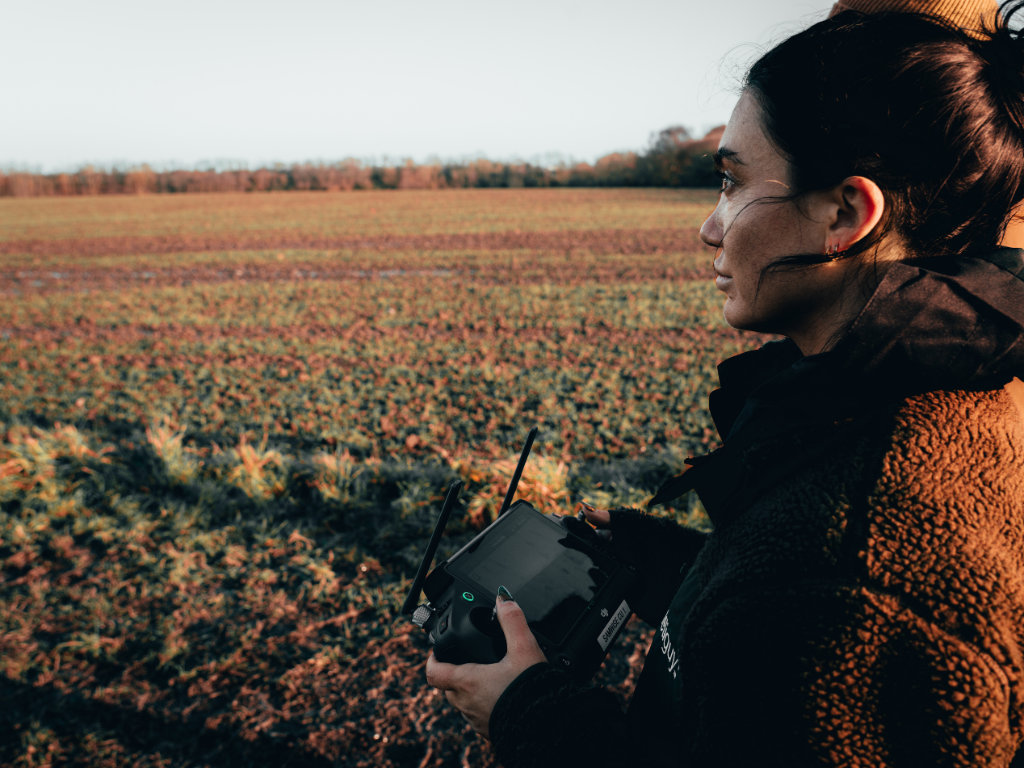
Case Studies
Published on 2 Dec 2024
Jamie Collier
Meet Your Net Zero Goals with Drones: Best DJI Drones for Becoming Carbon Neutral
Discover how drones are transforming industries by reducing carbon footprints while improving efficiency and accuracy.
Learn how drones are advancing sustainability across industries like forestry, construction, and agriculture by helping businesses reduce their carbon footprint and meet their net zero goals;
Drones save businesses time and money by reducing the need for fuel and costly equipment rentals while also enhancing productivity;
Drones are proving to be a long-term solution to help organisations significantly reduce their carbon footprint;
Drones offer a feasible alternative to fuel-intensive helicopters;
Thanks to their compact design and manoeuvrability, drones equipped with specialised cameras yield accurate results while minimising environmental disruption;
Drones produce less noise and eliminate fuel or smoke, making them a cleaner and quieter alternative;
Utilise heliguy™’s extensive training pathways and resources to start and scale your drone programme.
As businesses strive to meet their net zero targets, many are turning to drones as they offer significant advantages over traditional methods, such as reducing carbon emissions, improving efficiency, and promoting environmentally friendly practices.
From monitoring forests to surveying construction sites, drones are providing businesses with practical, low-carbon solutions that align with their sustainability goals.
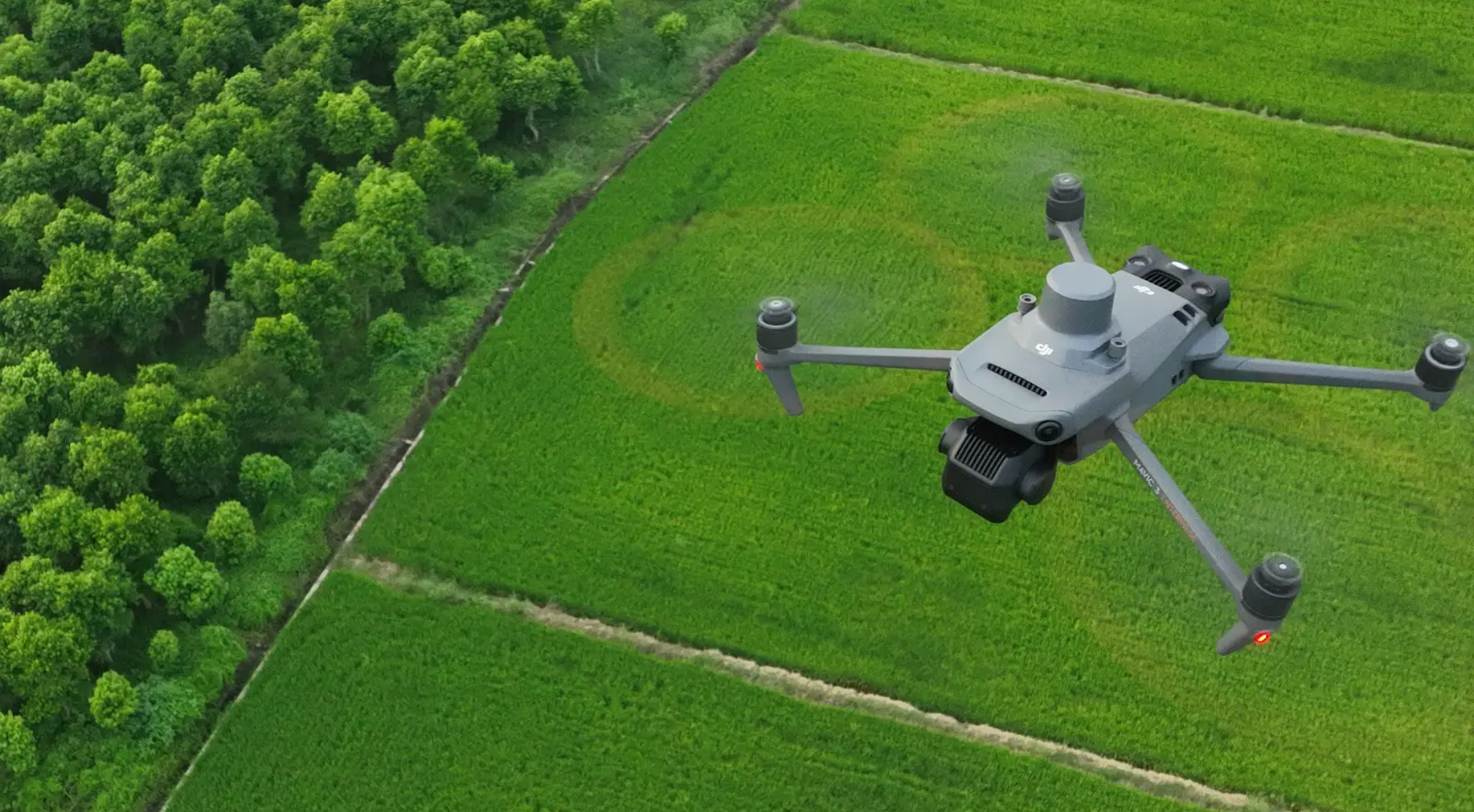
Achieving Net Zero with Drones: A Sustainable Solution
By integrating drones into logistics, businesses can cut traffic congestion, reduce fuel consumption, and decrease emissions.
Traditional transportation methods like trucks, helicopters, and ships are often necessary for inspections, deliveries, and remote monitoring. However, these methods have high fuel consumption and significant greenhouse gas emissions, whereas drones offer a cleaner, greener alternative.
Site inspections often contribute to emissions from helicopters, heavy machinery, large crews, and extensive driving. Drones provide a sustainable solution by allowing a single pilot to deploy the drone, collect data, and use thermal or night vision payloads, significantly reducing the need for extensive operations.
heliguy™ client Keltbray, a leading UK construction engineering company, won the prestigious Gold Green Apple World Environmental Award for its innovative use of drones in utility inspections.
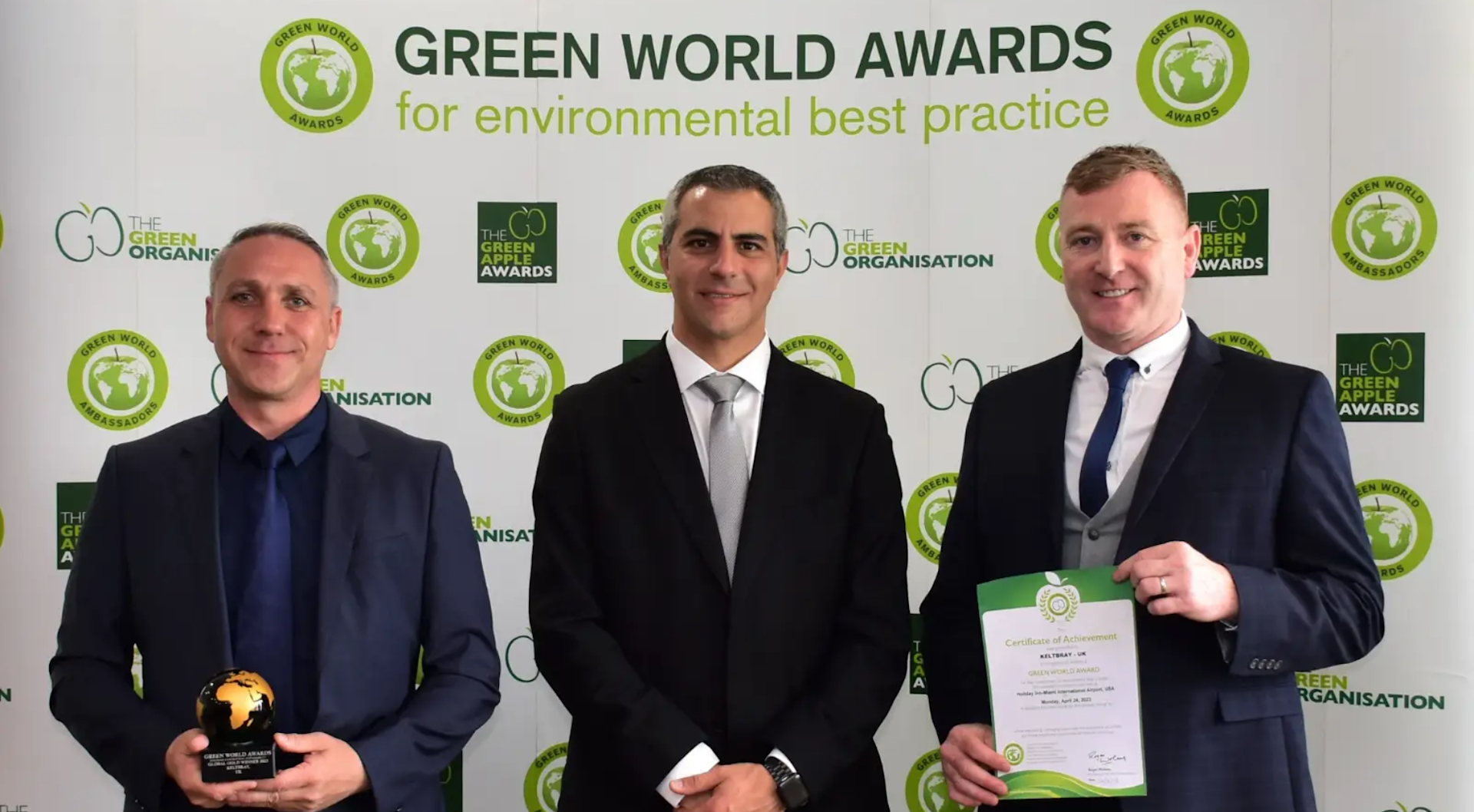
By employing the DJI M300 with the H20T and P1, Keltbray revolutionised powerline inspections, reducing the carbon footprint of traditional methods by 50%.
This achievement highlights just how impactful drones can be in lowering carbon emissions.
Keltbray Carbon Emissions Comparison:
Equipment | Total Carbon Emissions (kgC)2e/per tower) | |
Traditional Methods | Vans x 2 4x4 x 1 Argocat x 1 | 62.6, including 19.5 from the argocat. |
M300 RTK Drone Inspection | 4x4 x 2 Drone x 1 | 34.2, including 0.04 from the drone. |
Drones have enabled Keltbray to collect thermal imagery, reducing the need for all-terrain vehicles and replacing helicopters for LIDAR surveying. Additionally, they've eliminated the need for staff to work at height or traverse rugged terrain, allowing for detailed defect identification, reducing asset downtime, and cutting inspection costs.
Keltbray’s drone programme makes utility inspections more efficient, minimises the need for machinery and personnel, and reduces disruption to the surrounding environment.
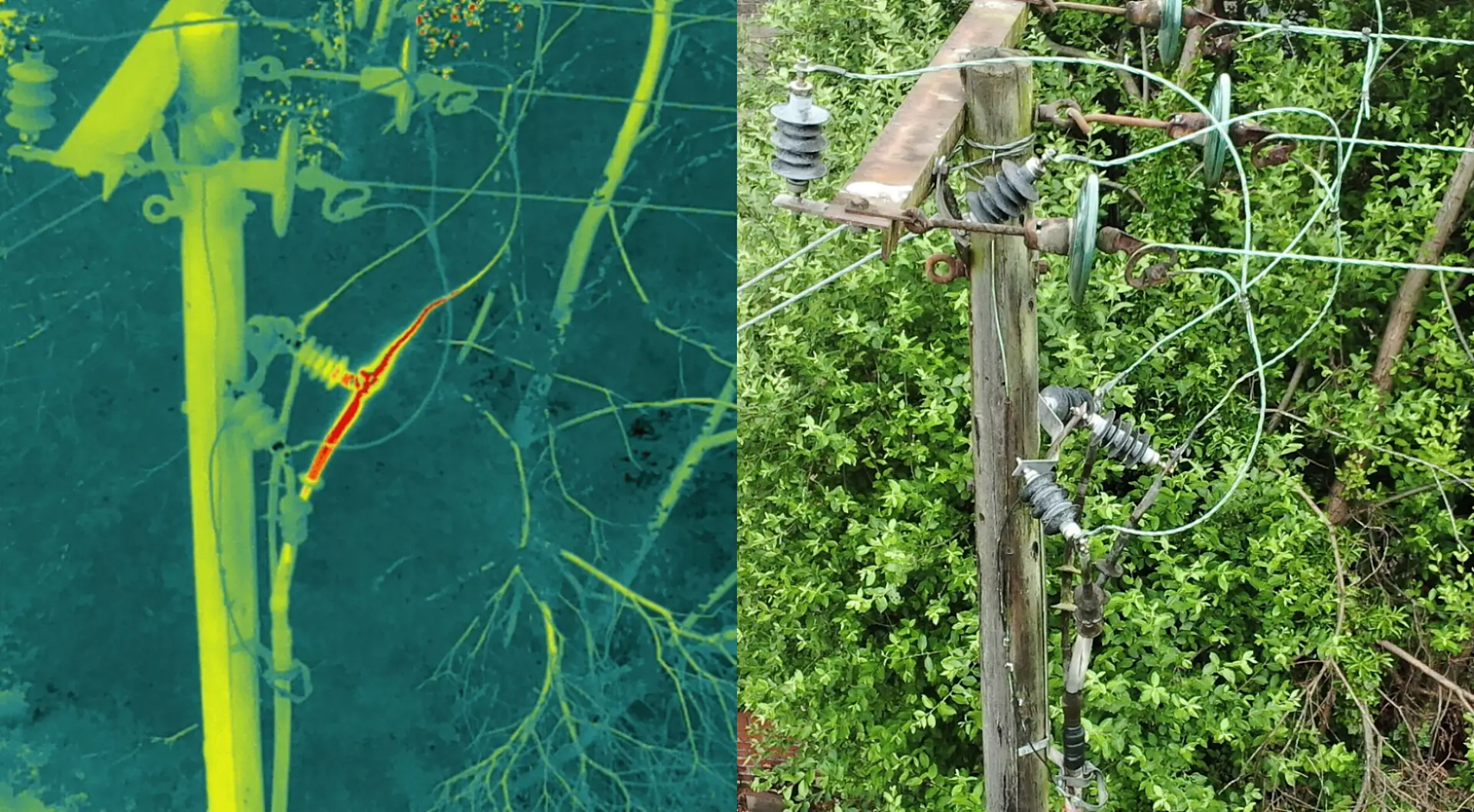
Thermal data set from Keltabray powerline inspection
Drones can have a similar positive impact on transporting goods. Specifically made for delivery, the DJI FlyCart 30, with its Cargo and Winch modes, ensures safe and efficient air transport, whether moving stock from ships to ports or delivering packages.

Drones vs Helicopters: A More Sustainable Option
Unlike helicopters, which are fuel-intensive and emit high levels of CO₂, drones offer a greener, electric-powered alternative.
Drones are increasingly used for tasks traditionally handled by helicopters, such as inspection and search and rescue. They consume less energy and are more cost-effective, making them ideal for businesses looking to cut emissions and operate sustainably.
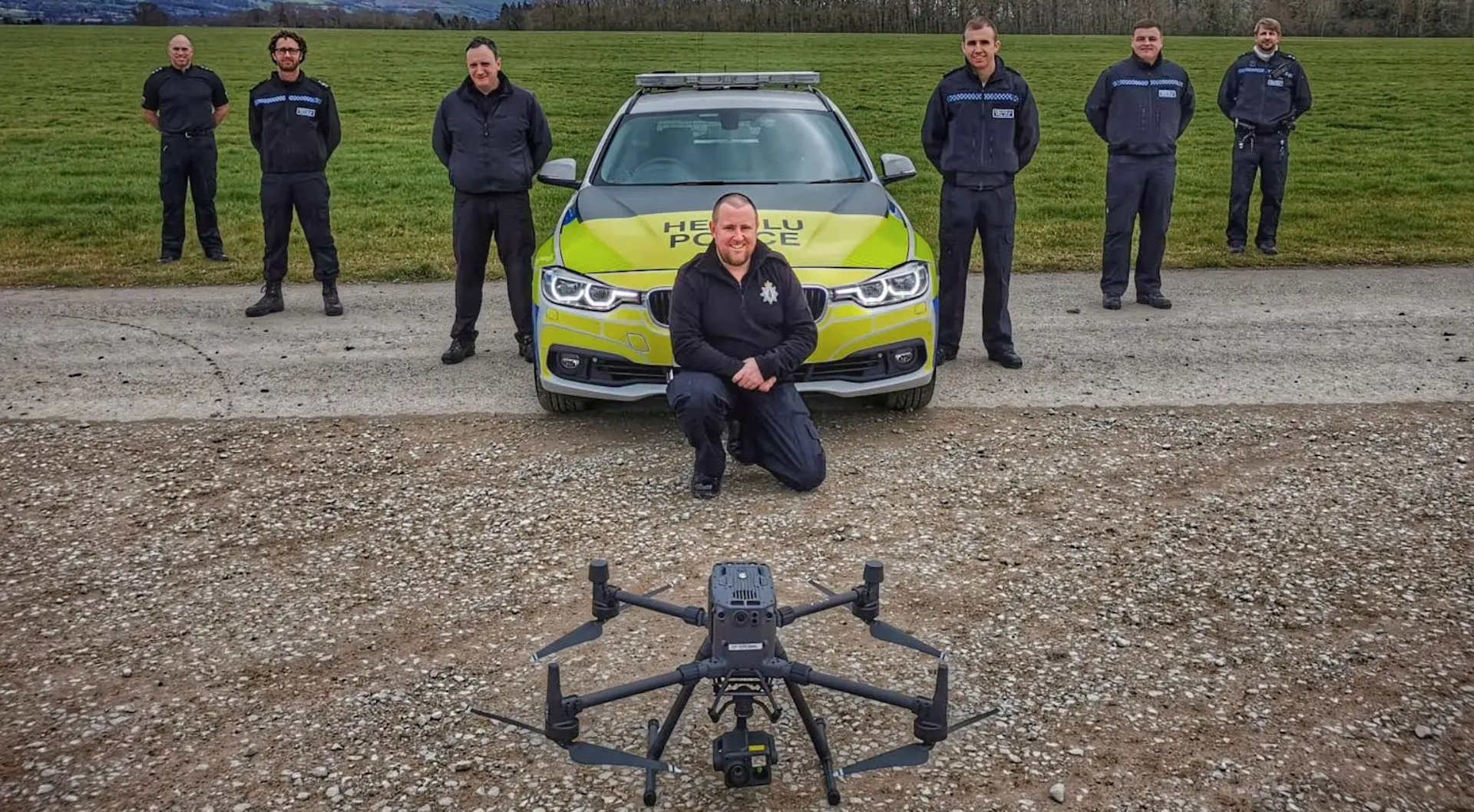
North Wales Police Unit.
A key driver in drone adoption is their ability to replace helicopters in many industries that previously had no alternative. For example, police departments now deploy drones for search and rescue operations, reducing costs, minimising disruption, and benefiting from drones’ greater manoeuvrability and efficiency—delivering a more sustainable solution without compromising effectiveness.
The North Wales Police used the DJI M300 RTK and H20T camera to locate a missing person. The drone’s ability to fly close to the ground and capture detailed images from above—unachievable by helicopter—allowed precise monitoring of areas where officers were searching on foot, leading to the successful location of the missing person.
The helicopter can do all of these things too, but at a greater expense. We can be deployed alongside officers on the ground to multiple locations during an operation over a number of hours, carrying out multiple drone flights throughout an operation and at much lower cost.
Lead pilot Sergeant Paul Terry of the North Wales Police.
Using drones over helicopters for these missions streamlines operations. Unlike helicopters requiring repeated launches, drones can be deployed with precision, leaving a minimal carbon footprint.
Remote Monitoring: Drone-in-a-Box Minimises the Need for In-Person Inspections
Drone-in-a-box systems will soon reduce the need for physical site visits, with drones docked on-site and deployed on-demand for real-time inspections. This innovation helps businesses reduce travel, cut emissions, and enhance operational efficiency.
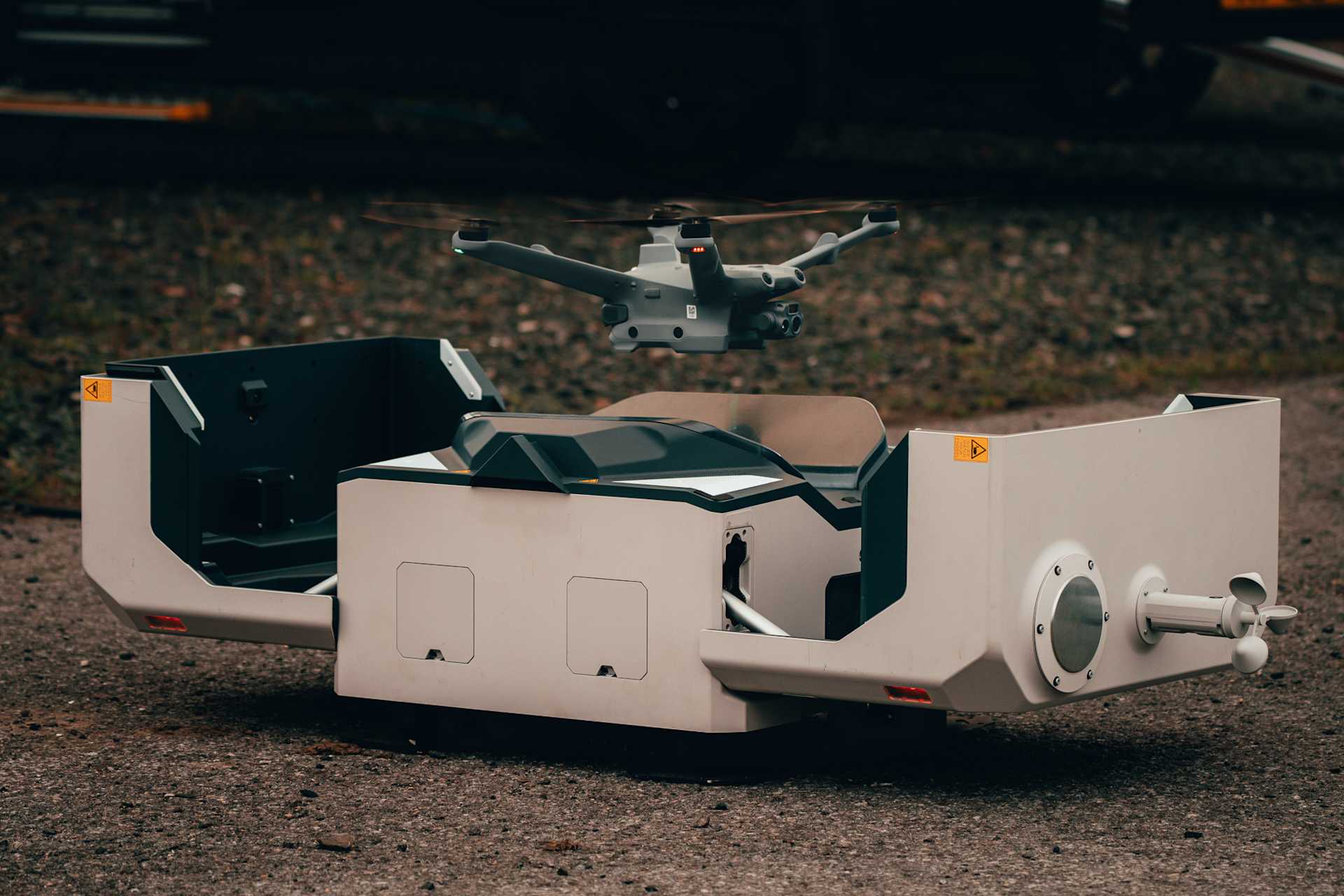
heliguy™ hosted the UK’s first DJI Dock demonstration at Komatsu UK’s Smart Construction site, showcasing the benefits of remote, automated drone operations. Key highlights included 24/7 on-demand deployment, global enterprise use cases, and secure drone-in-a-box software for planning and data centralisation. Industry experts emphasised the Dock’s potential for enhancing autonomy and improving operational efficiency, with BVLOS integration encouraged as legislation evolves.
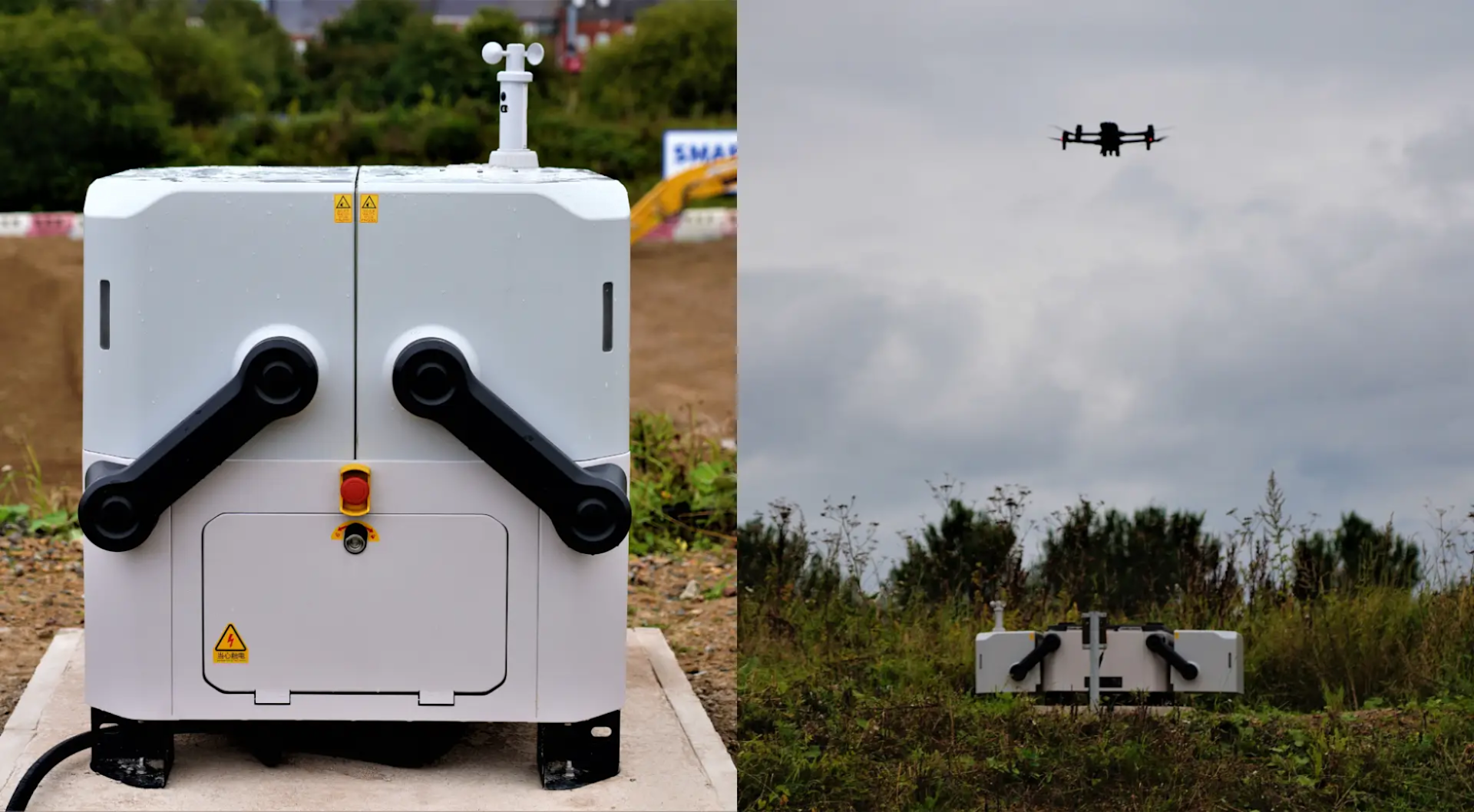
The UK Civil Aviation Authority (CAA) is taking steps to modernise UK airspace; collaborating with industry leaders across multiple sectors, the CAA is gathering vital safety data on drone detection, avoidance, and communication with air traffic control.
Current projects demonstrating the potential of BVLOS include:
Amazon Prime Air: Drone deliveries.
Airspection: Offshore wind farm inspections.
NPAS: Policing with uncrewed aircraft.
NATS: BVLOS inspections over the North Sea.
Project SATE: Flights to Orkney.
Project Lifeline: Medical deliveries.
A great example of the DJI Dock 2 in action is the Police trial in Norfolk, where drones are tested as first responders. The National Police Chiefs’ Council highlights that drones improve public and officer safety while enabling faster responses. Remote monitoring reduces emissions from car patrols, allowing forces to cover large areas more efficiently and be directed to exact locations.
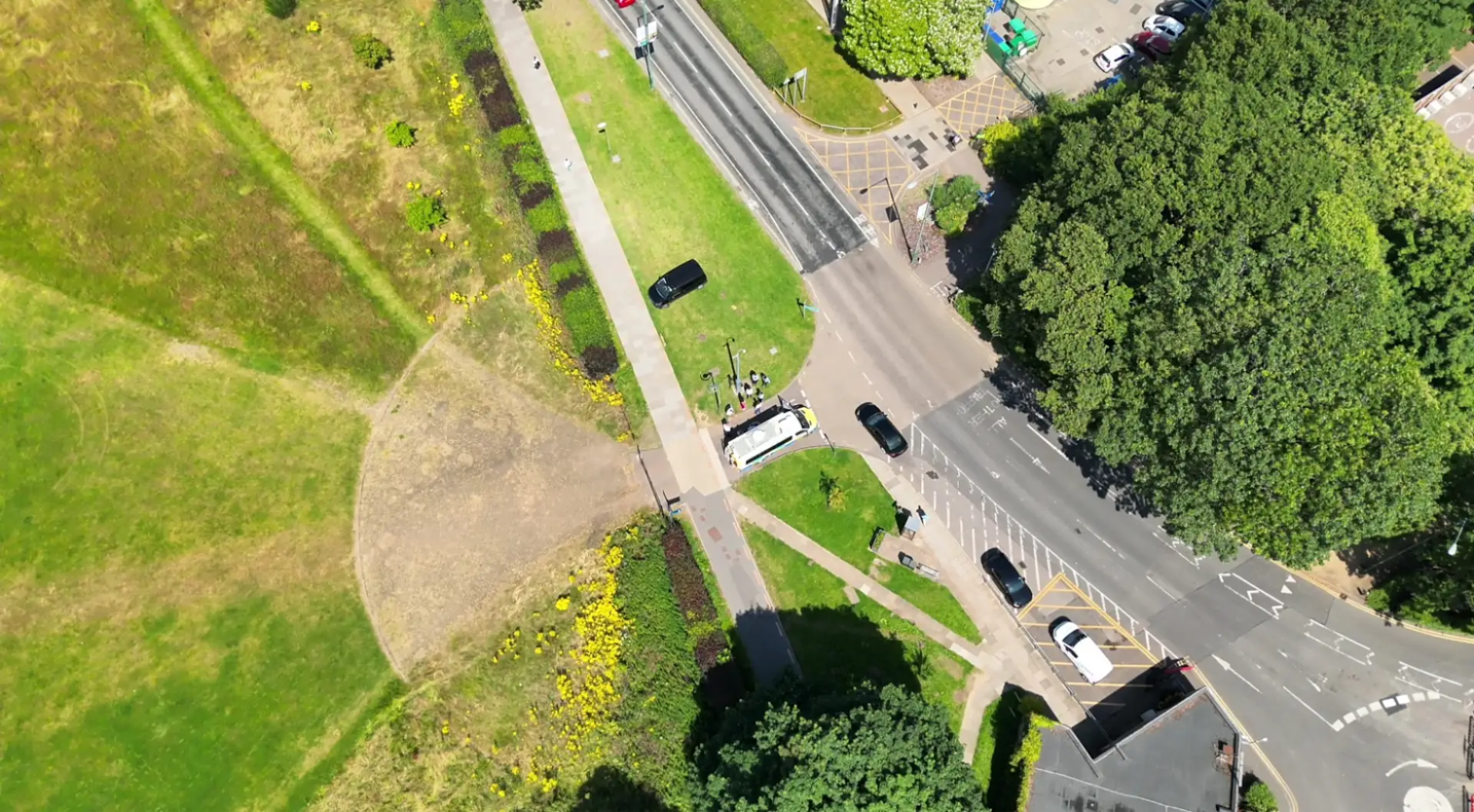
Drones in Forestry & Environmental Management: Minimising Wildlife Disruption
The forestry industry is increasingly using drones for monitoring, replacing time-consuming manual methods and costly helicopter flights that often disrupt wildlife. Drones offer more accurate data by enabling closer, quieter inspections and utilising thermal and multispectral cameras to monitor animals and plant health with minimal disturbance.
The Woodland Trust revolutionised its deer surveys by using the DJI M300 RTK drone series with the H20T payload for their annual census. The thermal sensor detects deer locations, while the RGB camera assesses the animals in detail. This approach provides essential data for evaluating deer populations, tracking health, and spotting environmental issues—tasks that were previously challenging due to the disruptive nature of helicopters.
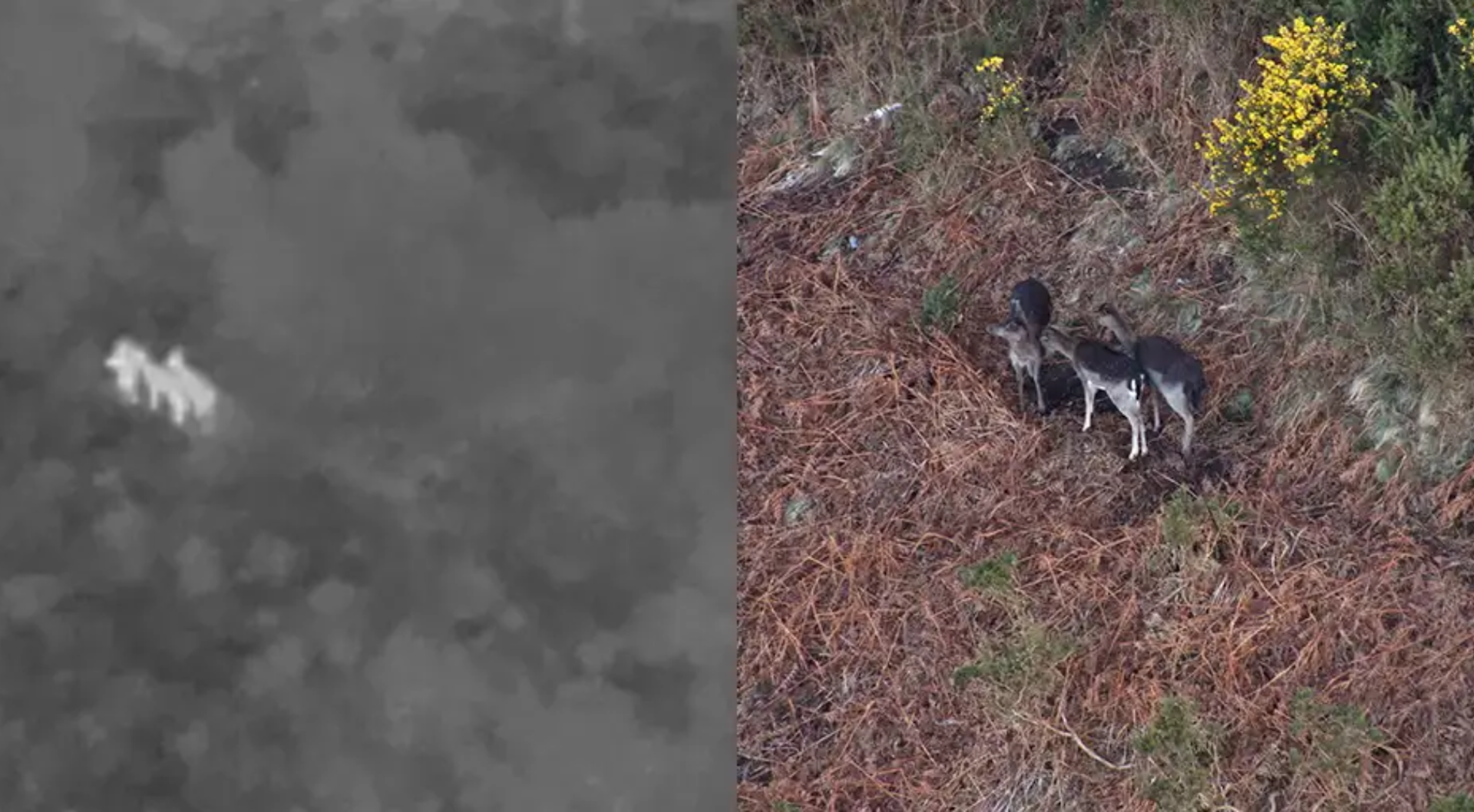
Data from Woodland Trust Survey, Night Vision and RGB, side-by-side.
As this data is only gathered once a year, the Woodland Trust uses the heliguy™ rental service, benefiting from cost-effective, on-demand access to specialised equipment. This setup has allowed them to capture high-quality, low-impact data, advancing wildlife and habitat management efforts.
Best DJI Drones & Payloads for Forestry:
M350 with the H30T for thermal surveying or the P1 for photogrammetry.
Mavic 3 Multispectral, for monitoring vegetation.
Mavic 3 Enterprise, for surveying tasks.
Drones in Agriculture: A More Eco-Friendly Solution for Farming
Agricultural drones are transforming farming by providing accurate data that enables precision agriculture, improving crop monitoring efficiency, reducing fuel consumption, and saving farmers both time and money.
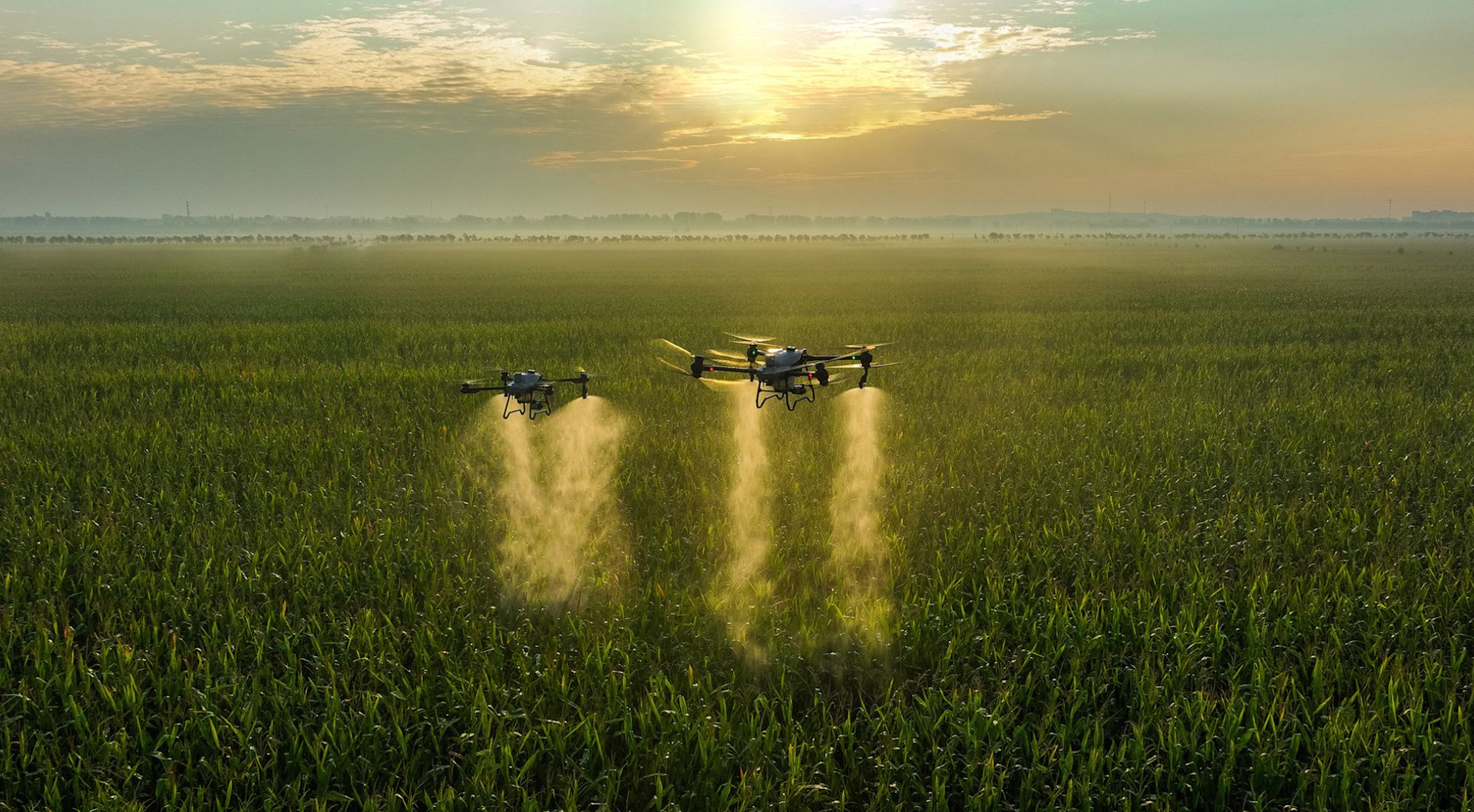
The Agras series offers a sustainable solution for seed dispersal, ensuring efficient, fuel-free distribution while minimising soil disruption. This approach promotes healthier crop growth and reduces environmental impact. In addition to seed-spreading, Agras drones feature built-in sprinklers for precise watering, allowing for even water distribution, helping to reduce wastage and enhancing plant health.
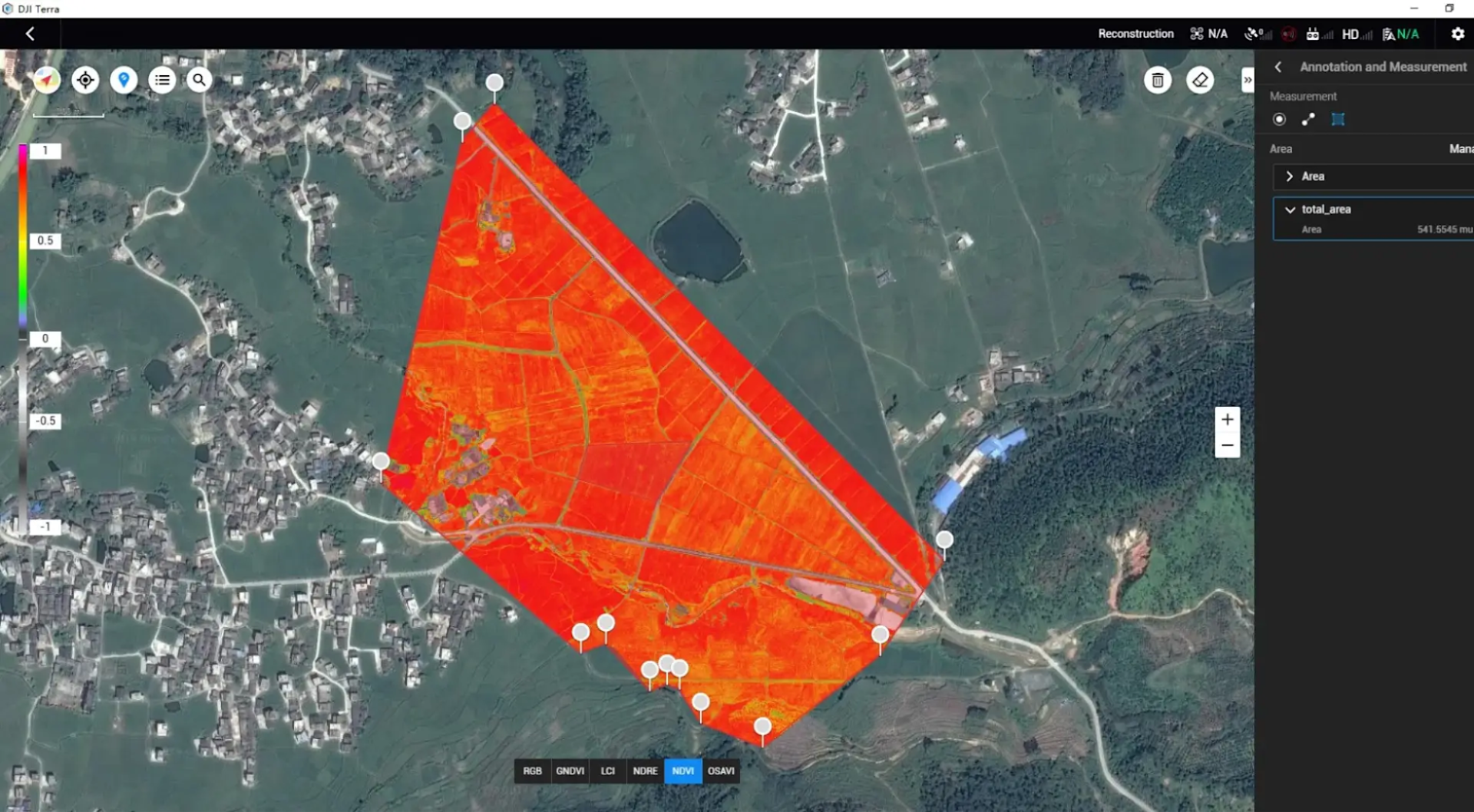
Multispectral data, the trees' health can be determined by the colour the camera displays.
Beyond standard farming tasks, multispectral drones, such as the DJI Mavic 3 Multispectral, are an invaluable tool for monitoring crop health. Multispectral imaging provides essential data for agriculture, land management, and forestry, offering insights that help monitor plant health, soil conditions, and biodiversity.
These insights lead to higher yields, improved productivity, and greater profitability. By identifying optimal planting locations, multispectral drones also enable farmers to maximise natural resources and make more informed decisions about crop placement.
Best DJI Drones for Agriculture:
DJI Mavic 3 Multispectral for crop monitoring.
Mavic 3 Enterprise, for surveying tasks.
Drones in Construction: Reducing Carbon Emissions in the Industry
The construction industry is a major carbon emitter, but drones are helping reduce its environmental impact. By replacing heavy machinery, drones minimise soil disruption, streamline site surveys, and lower fuel consumption and emissions, supporting the industry's shift towards carbon neutrality.
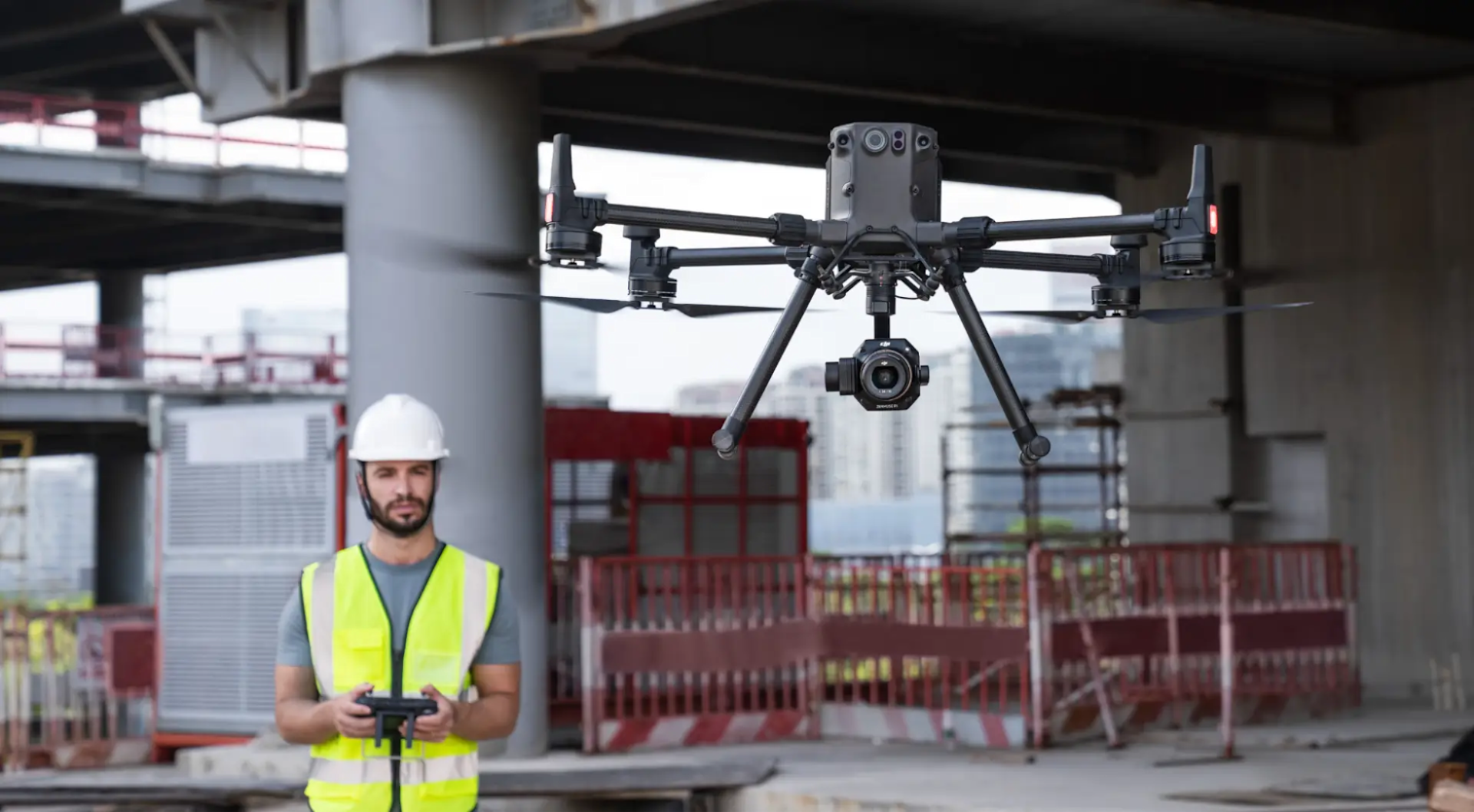
For example, drones were used throughout the construction process at Everton Stadium. Drone data was integrated into a digital 4D model for real-time updates and insights.
Drone LiDAR was employed for earthwork calculations and monitoring dock infilling, enabling efficient site monitoring, progress tracking, and logistics coordination. This data was incorporated into Laing O'Rourke's immersive suite, helping to visualise the construction sequence, assess risks, and optimise resource allocation.
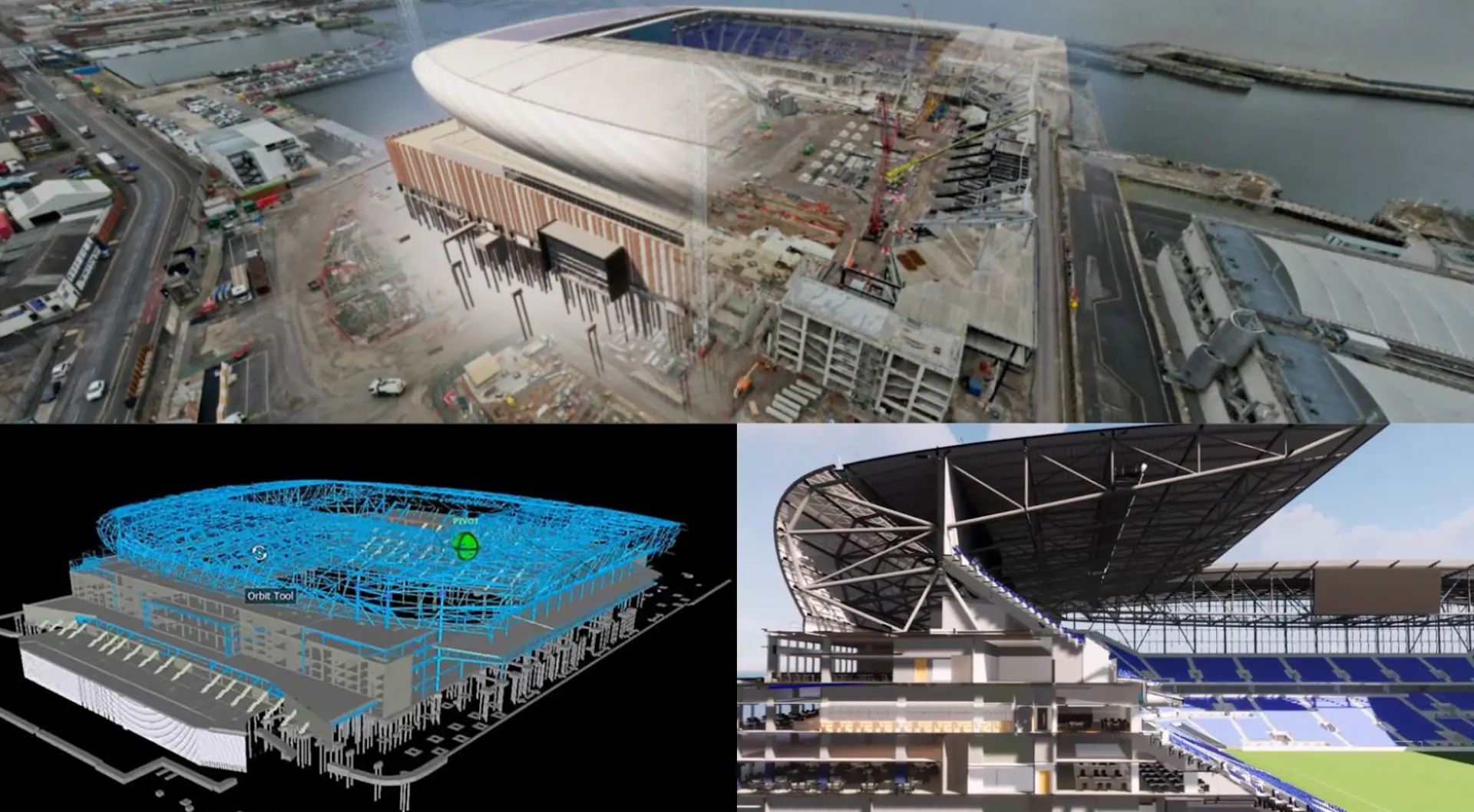
4D model of Everton Stadium over project timeline. By identifying problems early with regular drone inspections, construction crews can minimise the need for rework, avoid costly project changes, and reduce disruption, leading to more environmentally sustainable and structurally-sound buildings.
Best DJI Drones & Payloads for Construction:
M350 with the H30T for thermal surveying or the P1 for photogrammetry.
DJI Dock 2 with M3D or M3TD for site inspections and monitoring.
Mavic 3 Enterprise, for surveying tasks.
Check out our Construction Industry page to learn more.
Summary
Drones are playing a vital role in helping businesses meet their net-zero targets. By replacing fuel-consuming machinery, streamlining data collection, and enabling more sustainable practices, drones are reducing environmental impact across various industries.
Whether it’s monitoring wildlife, surveying construction sites, or managing forests, drones offer a versatile and efficient tool that businesses can use to lower their carbon footprint and move closer to a sustainable future.
Contact our Sales Team today to discover how drones can help your business achieve Net Zero, or connect with our Training Team to explore industry-specific options.
Related Products
DJI Dock 2 With DJI Matrice 3TD
£12,244.00
DJI Dock 2 With DJI Matrice 3D
£10,539.00
DJI M350 RTK Drone Only And H30T Combo
£18,949.00
DJI Matrice 350 RTK Drone Only
£8,389.00
Rental M350 RTK Super Combo
£649.00 weekly
Rental DJI Zenmuse H30T Thermal Camera
£429.00 weekly
Sale
DJI Zenmuse P1
£5,279.00
£6,100.00
Save £821.00
Rental Zenmuse P1
£314.00 weekly
DJI Mavic 3 Enterprise Drone
£3,080.00
Rental Mavic 3 Enterprise
£219.00 weekly
DJI Mavic 3 Multispectral
£3,698.00
Rental Mavic 3 Multispectral
£369.00 weekly
DJI Agras T50
Enquire now
DJI Agras T25
Enquire now
Related Products
DJI Dock 2 With DJI Matrice 3TD
£12,244.00
DJI Dock 2 With DJI Matrice 3D
£10,539.00
DJI M350 RTK Drone Only And H30T Combo
£18,949.00
DJI Matrice 350 RTK Drone Only
£8,389.00
Rental M350 RTK Super Combo
£649.00 weekly
Rental DJI Zenmuse H30T Thermal Camera
£429.00 weekly
Sale
DJI Zenmuse P1
£5,279.00
£6,100.00
Save £821.00
Rental Zenmuse P1
£314.00 weekly
DJI Mavic 3 Enterprise Drone
£3,080.00
Rental Mavic 3 Enterprise
£219.00 weekly
DJI Mavic 3 Multispectral
£3,698.00
Rental Mavic 3 Multispectral
£369.00 weekly
DJI Agras T50
Enquire now
DJI Agras T25
Enquire now
